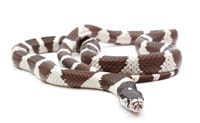Certain snake skins could help to develop engineering applications.
As snakes lack limbs, this means that their skin is being subjected to constant friction when they are moving. Professor Stanislav Gorb and Marie-Christin Klein, a Ph.D student, based at Kiel University in Germany, have been investigating the structure of the skin of these reptiles, and how snakes have adapted to facilitate their legless locomotion.
Having first appeared around 150 million years ago, snakes have subsequently colonized all continents aside from Antarctica. They are able both to burrow and climb successfully, with their skin being subjected to considerable wear as they move. The researchers set out to discover if and how the skin of snakes was optimized to protect against abrasion, thereby ensuring that it functions most effectively, before being replaced at the reptile’s next shed.
The scientists studied the skins of four species of snake. These were the sand boa (Gongylophis colubrinus); California king snake (Lampropeltis getula californiae), rainbow boa (Epicrates cenchria cenchria) and the green tree python (Morelia viridis), which are found in a range of different environments, from the desert to tropical trees.
What They Discovered
“With the help of these four species, we discovered that the skin architecture differs depending on habitat. However, all show a gradient in material properties. This means that the skin of all species has a stiff and hard outside and becomes more flexible and soft towards the inside, even though the skin differs in thickness and structure depending on species,” explains Klein.
She discovered that the four snakes have evolved different types of cell, depending on their environment. The skin can be relatively thick, with the cells having a rounded structure, or quite thin, while the cells are elongated in this case. According to Klein: “This speaks for a functional adaptation to legless locomotion, which has developed for snakes in both moist and dry habitats.”
A New Field of Research and Applications
“This research area is extremely new,” she adds. “The general composition of snake skin is known, however, but no-one has previously examined the impact of this on the mechanical material properties. A material that has a transition from a stiff outside to a flexible inside can distribute an impacting force over a larger area, therefore decreasing the force on one single point. Materials like this are like a flexible armor.”
These finding could be highly significant for bio-medical engineering, in terms of implants of various types, by minimizing the impact of abrasion. There may also be applications in the fields of propulsion and conveyor design, reducing the dependency on lubrication for effective, safe, long-term functioning.
Reference: Marie-Christin G. Klein and Stanislav N. Gorb. Epidermis architecture and material properties of the skin of four snake species J. R. Soc. Interface.


